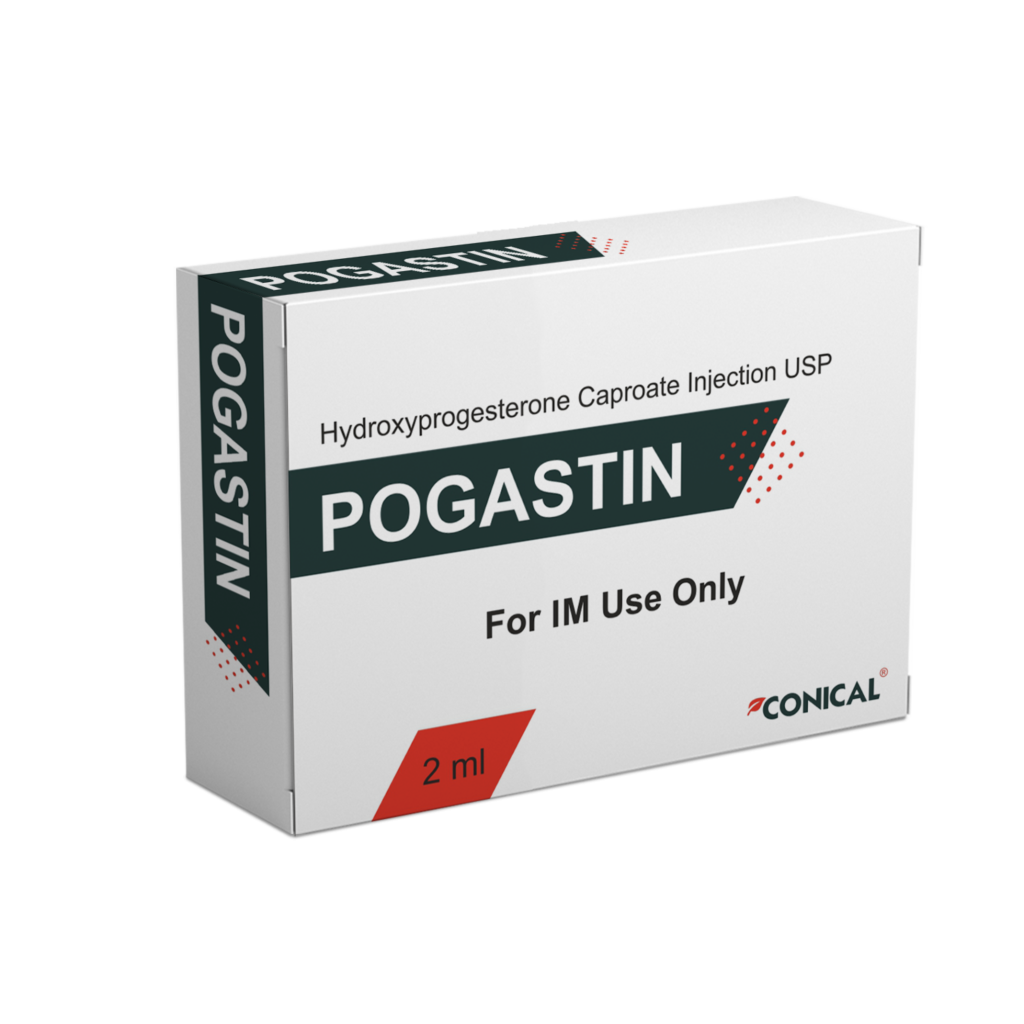







Hydroxyprogesterone caproate injection is a progestin indicated to reduce the risk of preterm birth in women with a singleton pregnancy who have a history of singleton spontaneous preterm birth. The effectiveness of hydroxyprogesterone caproate injection is based on improvement in the proportion of women who delivered < 37 weeks of gestation. There are no controlled trials demonstrating a direct clinical benefit, such as improvement in neonatal mortality and morbidity.
Limitation of use: While there are many risk factors for preterm birth, safety and efficacy of hydroxyprogesterone caproate injection has been demonstrated only in women with a prior spontaneous singleton preterm birth. It is not intended for use in women with multiple gestations or other risk factors for preterm birth.
Thromboembolic Disorders
Discontinue Pogastin if an arterial or deep venous thrombotic or thromboembolic event occurs.
Allergic Reactions
Allergic reactions, including urticaria, pruritus and angioedema, have been reported with use of Pogastin. Consider discontinuing the drug if such reactions occur.
Decrease in Glucose Tolerance
A decrease in glucose tolerance has been observed in some patients on progestin treatment. The mechanism of this decrease is not known. Carefully monitor prediabetic and diabetic women while they are receiving Pogastin.
Fluid Retention
Because progestational drugs may cause some degree of fluid retention, carefully monitor women with conditions that might be influenced by this effect (e.g., preeclampsia, epilepsy, migraine, asthma, cardiac or renal dysfunction).
Depression
Monitor women who have a history of clinical depression and discontinue Pogastin if clinical depression recurs.
Jaundice
Carefully monitor women who develop jaundice while receiving Pogastin and consider whether the benefit of use warrants continuation.
Hypertension
Carefully monitor women who develop hypertension while receiving Pogastin and consider whether the benefit of use warrants continuation.
Administer intramuscularly at a dose of 250 mg (1 ml) once weekly (every 7 days) by a healthcare provider
Begin treatment between 16 weeks, 0 days and 20 weeks, 6 days of gestation
Continue administration once weekly until week 37 (through 36 weeks, 6 days) of gestation or delivery, whichever occurs first
The most common adverse reactions reported in ≥ 2% of subjects and at a higher rate in the Pogastin group than in the control group were injection site reactions (pain [35%], swelling [17%], pruritus [6%], nodule [5%]), urticaria (12%), pruritus (8%), nausea (6%) and diarrhea (2%).
Postmarketing Experience
The following adverse reactions have been identified during postapproval use of Pogastin. Because these reactions are reported voluntarily from a population of uncertain size, it is not always possible to reliably estimate their frequency or establish a causal relationship to drug exposure.
Body as a whole: Local injection site reactions (including erythema, urticaria, rash, irritation, hypersensitivity, warmth); fatigue; fever; hot flashes/flushes
Digestive disorders: Vomiting
Infections: Urinary tract infection
Nervous system disorders: Headache, dizziness
Pregnancy, puerperium and perinatal conditions: Cervical incompetence, premature rupture of membranes
Reproductive system and breast disorders: Cervical dilation, shortened cervix
Respiratory disorders: Dyspnea, chest discomfort
Store below 30°C. Protect from light. Do not freeze.
Once opened, use immediately and discard any unused contents.
Do not use solution if any foreign particles observed.
Keep the medicine out of reach and sight of children.
For human use only.
2 ml amber color ampoule along with package insert. 500 mg/ 2 ml
Contact us directly to receive full information on the product, the formulation, the science behind it, stability data, and more. Our Business Development Manager is a click away.
Questions are useful tools, they open lines of communication; give us information; improve interactions, facilitate analysis, and many more.
A pharma CMO is a special kind of an organization, offering contract manufacturing services to pharmaceutical companies for various kinds of drug formulations.
Reduce overall costs and time to market :
Contract manufacturers already have the needed infrastructure and technical staff, so working with a CMO or CDMO can decrease the cost of manufacturing your pharmaceutical products.
Scalability and flexible production capacity :
You can produce what you need when you need it without worrying about excess capacity. Additionally, CMOs understand the importance of quality and compliance, so you don't have to sacrifice safety for scalability.
Save on upgrading and maintaining equipment :
If you have your manufacturing facility, you’ll have to pay to upgrade your equipment as technology advances—which can get expensive. A CMO/CDMO’s only function is to make and distribute products, so part of their core business responsibility is to update their equipment whenever needed and perform maintenance.
Ease supply chain issues :
During the pandemic, there were several instances of supply chain issues, including medicine shortages. CMOs are generally better equipped than startups to handle a supply chain crisis.
Bandwidth to focus on core competencies
When your company resources aren’t directly allocated to manufacturing and distribution, you have more time to focus on other tasks, like marketing your new drug, researching, or working on drug discovery.
We have 7+ manufacturing sites with a minimum of WHO GMP certification and other country-specific approvals like NAFDAC approved, PPK Kenya Approved, TFDA Tanzania Approved, EU-GMP Approved.
We have below manufacturing capacity:
For Tablet, Capsule, and soft gel: up to 1 million units per shift
For Syrup: up to 0.05 Million per shift
For Ampoule and Vial: up to 0.1 million units per shift
For Ointment and Cream: up to 0.1 million units per shift
For Suppository: 0.1 Million units per shift
